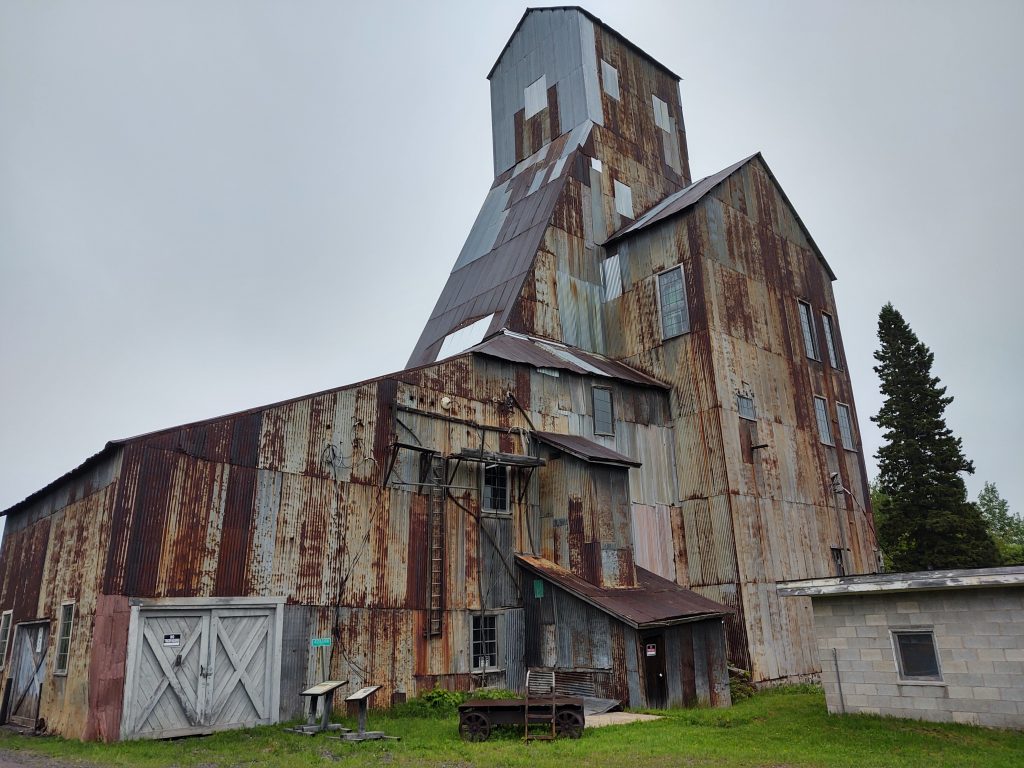As we hiked around the Keweenaw peninsula in upper Michigan we came across copper mining ruins. How did they mine copper? When did this industry cease production? How rustic were the mining towns? It was fascinating discovering the secrets of copper mining!

We found a smoke stack probably constructed in the late 1800’s.


40,000 years ago two mile thick ice sheets smashed mountains at a triple junction. There were three tectonic plates rumbling with a volcano underneath. This ancient occurrence caused the development of the Keeweenauwan Rift of 1,200 miles of copper. There are copper deposits around the world. (Currently, Chile, Peru and China lead in copper production.) At the turn of the 18th century, the Keweenau peninsula of Michigan was one of the leaders in copper mining.

Photo courtesy of Alamy Stock Photos
Mining ruins in the Keweenau Peninsula, “Copper Country,” reveals the hard work and determination of a long gone generation. This 47 mile long peninsula juts into Lake Superior on the western side of Michigan’s upper peninsula. Many relics lie in the rubble of the mines, stamp mills and smelting processors. Our self guided tour led us to several of the small mining towns: Freda, Beacon Hill, Redridge, Painesdale, Calumet, Mohawk and Gay.
In 1842 the Chippewa tribe signed over 30,000 square miles to the United States government. There was evidence that the area had been previously mined as long ago as 5,000 – 1,200 B.C.E. Copper producing pits and artifacts of copper tools had been found in the region. (These items are on display at Fort Wilkins.)

As we strolled around Freda, an old mining village, Jim Marin was walking his dog. Jim shared that he had worked at the Freda stamping mill in the mid 1960’s right before it closed. His father had worked there as well. He shared stories of mining days and of the bustling town of Freda. Jim invited us to his house where he had a collection of copper ore.

Jim took a greenish rock (on the left above) and rubbed it against the brick of his house to reveal shining copper. He then handed me the ore to keep. It was a gracious gift. It was remarkably heavy for such a small piece. Then, Jim proudly handed Chuck the large piece (pictured on the right). The Restless Viking handled the piece with ease. Jim returned the ore to the ledge.
Jim and his wife, Barb, live in Freda. They are two of a couple dozen residents who now live in this once booming mining town of 500 people.
In the 1890’s Charles Wright longed to make the most of this mining opportunity. After several failures at partnerships due to the economy: 1893 financial panic and 1898 The Spanish American War. Charles Wright approached William Alfred Paine for funding. Paine had previously invested in mining companies in the peninsula and a railroad in China.

Paine had visited the Keeweenau Peninsula on several occasions, yet he resided in Boston where he managed The Paine-Webber brokerage firm. Previously, Paine had met his business partner, Wallace Webber, while working as bank clerks where they learned the functions of investing. Webber stayed with their firm for a short period. William A. Paine continued to oversee the firm and create one of Boston’s most revered brokerage houses. I bet you’ve heard of “Paine-Webber.” By 1920 he was considered the wealthiest man in New England. Paine was quoted in the 1928 The American Magazine interview, “My philosophy is simple: The great thing in business is to know what you want to do. Then, do it.”
William A. Paine was interested in Charles Wright’s plan. Surveying began in 1898. This was accomplished by Thomas Appleton and W.W. Stockley and their crews. Bridges were constructed by the Phoenix Bridge Company spanning heights of 65 -85 feet with lengths of 1,400 feet. The railroad construction was built during a harsh winter and by May of 1899 the Champion Mining Company started mining copper along the western shore of the Keeweenau Peninsula. Champion Mining Company was a subsidiary of the Copper Range Consolidation headed by . . . William Alfred Paine.

Curiously, I found that William Alfred Paine labeled many entities in Michigan after himself. One settlement was the town of Painesdale. Beacon Hill is another settlement. One of his companies, Painesdale Mine and Shaft Inc. was a flourishing business in the early 1900’s. It is said that he named the settlement of Freda for his daughter. However in my research, William didn’t have a daughter or son who carried a name such as “Freda.” I believe he named this, too, after himself using his middle name, Alfred. His five children were Ruth Sargent (named for his wife), Esther Humphrey, Stephen, Francis Ward and Dorothy Bowen.


In 1902 production was in full swing. After being brought up by the miners from one of four mining shafts, the chunks of ore would be “stamped” by flat square plates made of iron. (See photos below) Mixing with water from Lake Superior this pressure and pounding of the rock would form a slurry. The slurry would have about 40% copper. It could then be shipped or sent by train to a smelting factory in Houghton. Smelting is the process of using heat and water to separate the copper from the rock. The pliable copper is formed into bars or ingots for distribution and production of goods.



In an act of charity and devotion for his love of learning, William A. Paine dedicated the Sarah Sargant Paine Memorial Library to the community of Painesdale in memory of his mother. (Pictured below) She had been devoted in her care for William who had been a sickly child. The year was 1903. It became the center of activity in the town. (Unfortunately, due to a lack of upkeep the large stone structure was demolished in 1960.)

William A. Paine’s gift to the Painesdale community in 1903
Worried about copper being wasted and thrown out with the tailings (broken rock) from the stamping method, a set of drums were installed in the Freda factory as an experiment. (1906) Copper ore was rotated inside these drums along with steel balls designed to separate rock from the copper. This was found to be less effective than the traditional stamping method. The drums were removed and by 1907 Freda had six stamping machines which moved 3500 tons of copper ore slurry daily.

effective than the stamping process.
In 1907 a post office began to operate in the mining town of Freda. This ability to communicate by letter was a huge benefit to the 500 residents. (Today, less than 30 people live in Freda.)

Freda Park opened in 1908 which was solely funded and maintained by Copper Range Railroad, owned by William Alfred Paine. The park became a resort destination for the whole area. Up to fourteen passenger train cars draped with bunting would carry vacationers to and from the park. The front of the train was decked with two white flags to demonstrate the formality of fun. The park was a desired attraction and drew in settlers and vacationers alike.

By 1910 the population of Freda was steady – around 500 residents. The main features were the stamp mill (which crushed copper ore from the mines), a saloon, a hotel, a barber, physician and a congregational church. Miners often lived in boarding houses made up of six rooms. The cost for one room would be $1.00 each month. Miners also paid $0.50 each month to cover any needed medical treatment. Injuries happened often. If one required hospitalization it would cost an additional $1.00 per day. If a miner died or was no longer able to work, his family would received a letter requiring them to vacate their home within sixty days. After all, the housing was owned by the mining company. They needed the dwellings to be filled with productive, able bodied workers.

Photo courtesy of the Freda Historical Society
In 1915 a Catholic church was built in Freda. There were two hotels ran by George Fraser and Napoleon Mercier. The population remained around 500. Then the Freda movie theater was built in 1917.
With the invention of automobiles, fewer people traveled by train. Freda Park was sadly closed in 1918.

In 1930 men worked at the 48th level of the fourth shaft 4,800 feet below the surface. Later this shaft was extended to 5,500 feet deep creating the 56th level.

In 1945 the shaft was closed and the heavy equipment was removed.
In 1948 the fourth shaft was reopened for work at the 18th level.
In 1954 shaft three was opened for work at the 18th and then the 12th level.

On November 4, 1967 the final whistle blew in Freda, Michigan. The mine was closed. It had been the identity of Freda which soon dissolved. Machinery, tools and lumber were removed to be reused elsewhere. This salvage process lasted two years.

In 1971, the rails of the Copper Range Railroad were removed and the mill that had crushed copper for half a century was shut down leaving Freda a ghost town.

Witnessing the remains of an industry that had once flourished and the lives that had shaped “Copper Country” was eerie. It wasn’t long ago that people built their lives around mining in the Keweenaw peninsula. This serves as an inspiration in how this area was developed by hard working visionaries. I marvel at the sweat and toil it took to build this copper mining empire. It serves as a stark reminder to enjoy one’s relationships and make the best of situations. As we can see nothing lasts forever.

Sources:
Monette, Clarence J., Freda Michigan, End of the Road, 1989
Fields, Richard A., Range of Opportunity: A Historic Studiy of the Copper Range Company, 1997
Mine Tours:
(906)-231-5542
Email painesdalemineshaft@yahoo.com
PO Box 332 Painesdale, MI 49955






2 thoughts on “Mining in Michigan”
My grandfather worked in a mine near Calumet. I visited there a few years ago, and it made me sad to see how desolate an existence it must have been. Thank you for sharing this article.
Kirsten Gaither
Kristen,
Thank you for sharing about your grandfather’s life story. Copper Harbor has so many intriguing secrets.